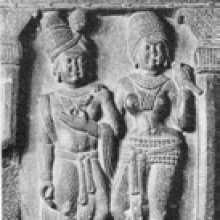Dove, Ḍōve: 3 definitions
Introduction:
Dove means something in Buddhism, Pali, biology. If you want to know the exact meaning, history, etymology or English translation of this term then check out the descriptions on this page. Add your comment or reference to a book if you want to contribute to this summary article.
Images (photo gallery)
In Buddhism
Tibetan Buddhism (Vajrayana or tantric Buddhism)
Source: academia.edu: The Structure and Meanings of the Heruka MaṇḍalaThe Dove (animal) is associated with the Yoginī (female deity) named Pārāvatī, being situated in the Vāyucakra, according to the 10th century Ḍākārṇava-tantra: one of the last Tibetan Tantric scriptures belonging to the Buddhist Saṃvara tradition consisting of 51 chapters.—Accordingly, the vāyucakra refers to one of the three divisions of the dharma-puṭa (‘dharma layer’), situated in the Herukamaṇḍala. The 36 pairs of Ḍākinīs [viz., Pārāvatī—“Dove”] and Vīras are dark blue in color; they each have one face and four arms; they hold a skull bowl, a skull staff, a small drum, and a knife.

Tibetan Buddhism includes schools such as Nyingma, Kadampa, Kagyu and Gelug. Their primary canon of literature is divided in two broad categories: The Kangyur, which consists of Buddha’s words, and the Tengyur, which includes commentaries from various sources. Esotericism and tantra techniques (vajrayāna) are collected indepently.
Biology (plants and animals)
Source: Google Books: CRC World Dictionary (Regional names)Dove in Vanuatu is the name of a plant defined with Alphitonia zizyphoides in various botanical sources. This page contains potential references in Ayurveda, modern medicine, and other folk traditions or local practices It has the synonym Rhamnus zizyphoides Spreng. (among others).
Example references for further research on medicinal uses or toxicity (see latin names for full list):
· Biographical Notes upon Botanists. (1965)
· Flora Indica (1855)
· Biographical Dictionary of Botanists Represented in the Hunt Institute Portrait Collection. (1972)
· D.S.B. (1981)
· Genera Plantarum (1789)
If you are looking for specific details regarding Dove, for example diet and recipes, side effects, chemical composition, pregnancy safety, extract dosage, health benefits, have a look at these references.

This sections includes definitions from the five kingdoms of living things: Animals, Plants, Fungi, Protists and Monera. It will include both the official binomial nomenclature (scientific names usually in Latin) as well as regional spellings and variants.
Languages of India and abroad
Kannada-English dictionary
Source: Alar: Kannada-English corpusḌōve (ಡೋವೆ):—[noun] = ಡೋವಿ [dovi].
Kannada is a Dravidian language (as opposed to the Indo-European language family) mainly spoken in the southwestern region of India.
See also (Relevant definitions)
Starts with: Dove plum, Dove-weed, Dover orange peruvian lily, Doveweed.
Full-text (+142): Kapota, Kapotapalika, Paravata, Vitanka, Kshinavasin, Sutrakantha, Kalarava, Khabutara, Khabuttara, Kapotika, Kabutara, Vagvilasin, Kaladhvani, Madanakakurava, Khurada, Manjughosha, Manipura, Kapotapetaka, Paravatashva, Kodaru.
Relevant text
Search found 87 books and stories containing Dove, Ḍōve; (plurals include: Doves, Ḍōves). You can also click to the full overview containing English textual excerpts. Below are direct links for the most relevant articles:
The Skanda Purana (by G. V. Tagare)
Chapter 45 - Trilocaneśvara (trilocana-īśvara-liṅga) < [Section 2 - Caturaśīti-liṅga-māhātmya]
Chapter 76 - The Power of Trilocana < [Section 2 - Uttarārdha]
Chapter 13 - The Greatness of Kapoteśa and Bilveśvara < [Section 2 - Puruṣottama-kṣetra-māhātmya]
Brihat Samhita (by N. Chidambaram Iyer)
Chapter 88 - Omens (3): On ominous cries (viruta) of Birds and Beasts
Chapter 71 - Omens from Slits of Garments (vastracheda-lakṣaṇa)
The Bhagavata Purana (by G. V. Tagare)
Chapter 7 - The Legend of the Avadhūta and his Preceptors < [Book 11 - Eleventh Skandha]
Chapter 12 - Birth of Parīkṣit < [Book 1 - First Skandha]
Chapter 20 - Manifestation of the Cosmic Form by Viṣṇu < [Book 8 - Eighth Skandha]
Puranic encyclopaedia (by Vettam Mani)
